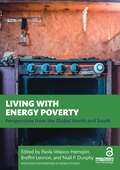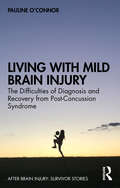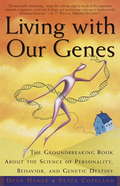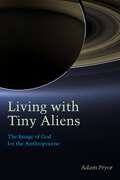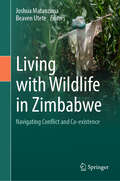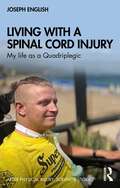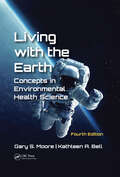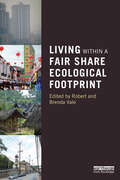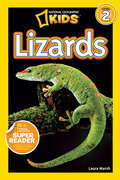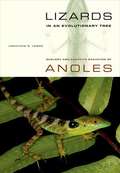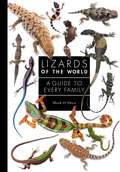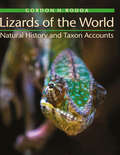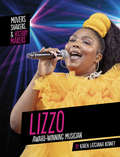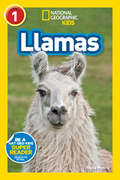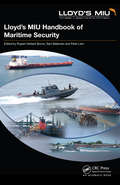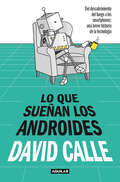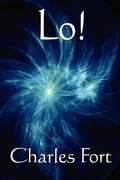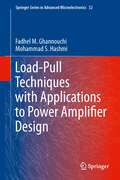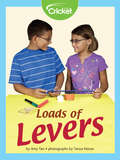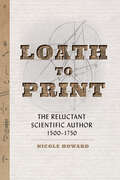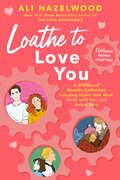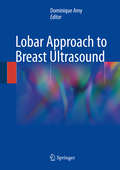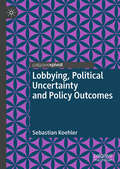- Table View
- List View
Living with Energy Poverty: Perspectives from the Global North and South (Routledge Explorations in Energy Studies)
by Paola Velasco-Herrejón Breffní Lennon Niall P. DunphyLiving with Energy Poverty: Perspectives from the Global North and South expands our collective understanding of energy poverty and deepens our recognition of the phenomenon by engaging with the lived experiences of energy-poor households across different contexts. Understanding the lived experience of energy poverty is an essential component in the design of any effort to alleviate what is fundamentally a deep-rooted, multi-faceted, wickedly complex problem. This requires a nuanced understanding of the causal factors and the research methods that can respond to the flexible spatial and temporal nature of the condition, as well as its wellbeing and justice implications. Drawing together the expertise and connectedness of authors from the Global South and North, this book presents novel approaches to understanding the often hidden forms of domestic energy deprivation. Case studies from 20 countries provide critical perspectives on this phenomenon while analysing the policy practices, government strategy, and sustainability implications of divergent manifestations. The book takes a multidimensional perspective, challenging the bias towards energy production and service provision, which often do not align with the aspirations and realities of energy households across global contexts, thus facilitating a useful dialogue on the nature of energy poverty. The book is a timely source for policymakers, practitioners, and scholars seeking fresh, diverse insights into the everyday reality of energy poverty and wanting to better understand the challenges a people-centred, just energy transition can present.
Living with Energy Poverty: Perspectives from the Global North and South (Routledge Explorations in Energy Studies)
by Paola Velasco-Herrejón Breffní Lennon Niall P. DunphyLiving with Energy Poverty: Perspectives from the Global North and South expands our collective understanding of energy poverty and deepens our recognition of the phenomenon by engaging with the lived experiences of energy-poor households across different contexts.Understanding the lived experience of energy poverty is an essential component in the design of any effort to alleviate what is fundamentally a deep-rooted, multi-faceted, wickedly complex problem. This requires a nuanced understanding of the causal factors and the research methods that can respond to the flexible spatial and temporal nature of the condition, as well as its wellbeing and justice implications. Drawing together the expertise and connectedness of authors from the Global South and North, this book presents novel approaches to understanding the often hidden forms of domestic energy deprivation. Case studies from 20 countries provide critical perspectives on this phenomenon while analysing the policy practices, government strategy, and sustainability implications of divergent manifestations. The book takes a multidimensional perspective, challenging the bias towards energy production and service provision, which often do not align with the aspirations and realities of energy households across global contexts, thus facilitating a useful dialogue on the nature of energy poverty.The book is a timely source for policymakers, practitioners, and scholars seeking fresh, diverse insights into the everyday reality of energy poverty and wanting to better understand the challenges a people-centred, just energy transition can present.Chapter 1 of this book is freely available as a downloadable Open Access PDF at http://www.taylorfrancis.com under a Creative Commons [Attribution-Non Commercial-No Derivatives (CC-BY-NC-ND)] 4.0 license.Chapter 2 of this book is freely available as a downloadable Open Access PDF at http://www.taylorfrancis.com under a Creative Commons [Attribution-Non Commercial-No Derivatives (CC-BY-NC-ND)] 4.0 license.Chapter 22 of this book is freely available as a downloadable Open Access PDF at http://www.taylorfrancis.com under a Creative Commons [Attribution-Non Commercial-No Derivatives (CC-BY-NC-ND)] 4.0 license.
Living with Mild Brain Injury: The Difficulties of Diagnosis and Recovery from Post-Concussion Syndrome (After Brain Injury: Survivor Stories)
by Pauline O'ConnorThis important book presents a unique, personal account of the impact a mild traumatic brain injury can have. It tells the story of Pauline, who was 33 when a late football tackle caused a bleed in her brain which went undiscovered for 18 months. The account includes descriptions of hidden symptoms of concussion and post-concussion syndrome, pitfalls in diagnoses, the uneven progress of recovery and the effect of the varied reactions which others have to an acquired brain injury. The author incorporates memories alongside extracts from clinic notes, diary entries and emails to reflect the disjointed progress of diagnosis and recovery as- although similar- no two head injuries are the same. Through this book, the reader gains an appreciation of the confusion experienced by many brain injury survivors, which sheds light on why some may develop unusual behavior or mental health issues, and how such issues can be alleviated. Brain injuries are poorly understood by the general public and this can lead to difficult interactions. Moreover, complications in diagnosis means some may not realize they have this milder form of brain injury. This book will enlighten brain injury survivors and affected families and allow professionals an insight into their patients’ experiences. As concerns grow over the risks which contact sports pose, this book shows how even mild brain injuries can wreak havoc with careers, relationships and one’s sense of self, but that a happy life can still be found.
Living with Our Genes
by Dean H. Hamer Peter CopelandNo two people behave exactly the same. There are overeaters and undereaters, alcoholics and teetotalers, over--and underachievers. We have adventurers and armchair travelers, Don Juans and wallflowers, the timid and the bold-and every possible mixture and variation. Living With Our Genesargues that genes are the single most important factor in the wondrous variability of human behavior. In the past, studies of twins supported the assumption that inheritance plays a major role in why we feel or behave the way we do. Now, scientists are developing an impressive arsenal of research to identify the individual genes that guide human behavior. Living With Our Geneswill help readers understand their particular genetic make-up and decipher the mysteries of genetically inherited behavioral traits. Chapters are organized by various traits or characteristics so that readers can quickly turn to the issues most pressing in their lives, whether it's body weight or moodiness. Timid folks will investigate the molecular role in shyness. The flirtatious will turn to the chapter on sex. Am I angry because my dad is angry? What is it about my personality that prevents me from getting along with my coworkers? Hamer decodes the genetics of each trait, based on the very latest scientific findings, and then shows how the genes express themselves in real people. In the tradition ofListening to Prozac,this is an anecdote-filled book that attempts to explain how we arrive at the idea of self in an ever-changing scientific landscape.
Living with Tiny Aliens: The Image of God for the Anthropocene (Groundworks: Ecological Issues in Philosophy and Theology)
by Adam PryorAstrobiology is changing how we understand meaningful human existence. Living with Tiny Aliens seeks to imagine how an individuals’ meaningful existence persists when we are planetary creatures situated in deep time—not only on a blue planet burgeoning with life, but in a cosmos pregnant with living-possibilities. In doing so, it works to articulate an astrobiological humanities.Working with a series of specific examples drawn from the study of extraterrestrial life, doctrinal reflection on the imago Dei, and reflections on the Anthropocene, Pryor reframes how human beings meaningfully dwell in the world and belong to it. To take seriously the geological significance of human agency is to understand the Earth as not only a living planet but an artful one. Consequently, Pryor reframes the imago Dei, rendering it a planetary system that opens up new possibilities for the flourishing of all creation by fostering technobiogeochemical cycles not subject to runaway, positive feedback. Such an account ensures the imago Dei is not something any one of us possesses, but that it is a symbol for what we live into together as a species in intra-action with the wider habitable environment.
Living with Wildlife in Zimbabwe: Navigating Conflict and Co-existence
by Joshua Matanzima Beaven UteteThis book provides a critical analysis of the interactions of humans and wildlife in Zimbabwe. It does not only document conflicts, but it also considers opportunities for co-existence that can result in the successful conservation practices within protected areas. The book offers empirically rich case studies from across different areas of Zimbabwe both urban and rural where people interact with animals both negatively and positively. Chapters in the book discuss these interactions through the different lens including the contemporary politico-economic crises prevalent in Zimbabwe, the failures and successes of the CAMPFIRE programme, and gender dynamics of conflicts. The book provides an update into the human–wildlife interactions situation in Zimbabwe. Data presented has policy implications within Zimbabwe and beyond. It contributes to different categories policy and mitigation measures including HWC mitigation strategies as well as conservation policy. Beaven Utete and Joshua Matanzima have brought together a fascinating collection of papers on human-wildlife conflict and coexistence in Zimbabwe. The authors highlight the views, values and needs of people living with wildlife. Voices that are still too often ignored in conservation practice, policy and science. This is essential reading for anyone interested in decolonizing conservation and the future of wildlife in Africa. Professor Jan van der Ploeg, Professor Inclusive Conservation, Van Hall Larenstein University of Applied Sciences, The Netherlands This is a valuable collection from a country we should hear much more from in the field of human-wildlife interactions studies. In addition to providing interesting case studies and data from Zimbabwe to inform and inspire international conservation efforts, I hope it will galvanize national and local efforts to tackle the complex challenges ahead for biodiversity conservation in Zimbabwe. Professor Simon Pooley, IUCN SSC Specialist Group on Human-Wildlife Conflict and Coexistence
Living with a Spinal Cord Injury: My life as a Quadriplegic
by Joseph EnglishJoseph English was living his best life when a car accident changed everything. He suffered life changing injuries, and the doctors told him there was no chance of recovery. Facing life as a quadriplegic, Joe lost his business, his romantic partner, and, for a while, his will to carry on. His story, told with extensive contributions from his family and friends, charts his journey from being dead at the roadside to finding something to live for as he recounts his progress from injury to survival. With absolute candour, Joe tells the whole story of his accident, his rehabilitation, and his recovery. Full of advice and suggestions from professionals in the rehabilitation journey, this book is remarkably frank about the struggles Joe has endured, and the times when he felt as if life wasn’t worth living. It addresses all the most difficult issues around life after paralysis, including loss of identity and letting go of the past, as well as providing practical information on topics such as assistive technology, financial claims and legal support. It also outlines the various roles of those in the rehabilitation team. His doctors and specialist practitioners give their unique perspectives into their processes and procedures, helping to demystify them, while Joe’s family and friends ask the kinds of questions readers will be asking too, making this an invaluable guide to what to expect for anyone going through a similar experience. The book shows – by lived example – that there is always more to live for. It is essential reading for those with paraplegia, quadriplegia and other spinal injuries, and their families, friends and care-givers. It is also valuable for neuropsychologists, neurologists and other rehabilitation therapists, as well as students in medicine, nursing, allied health and neuropsychology.
Living with the Earth, Fourth Edition: Concepts in Environmental Health Science
by Gary S. Moore Kathleen A. BellShelving Guide; Environmental ScienceThis is a groundbreaking and innovative book now in its fourth edition. The first edition won the CHOICE award for outstanding Academic Book while editions two and three became bestsellers on their own right. This fourth edition is packed with new updates on current world events associated with environmental issues and related health concerns. The author maintains traditional concepts and merges them with new and controversial issues. The book has been revised to include up-to-date topics with and a revised Web site with updated links.So what Coverage of emergency preparedness for environmental health practitioners Discussion of population dynamics especially with regard to overpopulation and underpopulation around the world and their respective influences on social, economic, and environmental concerns. The mechanisms of environmental disease, emphasizing genetic disease and its role in developmental disorders and cancer. Human behaviors and pollution are presented along with respect to their roles in cancer risk. The ever increasing issues surrounding emerging and re-emerging diseases around the earth and the introduction of an increasing number of emerging diseases. The growing problems of asthma and other health effects associated with air pollution. An exploration of the mechanisms of toxicity with special reference to the immune system and endocrine disruption. The ongoing issues of the creation and disposal of hazardous waste along with the controversies surrounding disposal are presented. The issues and benefits of recycling are explored. The use of HACCP in assuring food quality, food safety issues, and the Food Quality Protection Act are discussed. Numerous technical illustrations, charts, graphs, and photographs are included What on the Web? Test bank and study questions giving a complete review of the concepts covered. Search tools for online journals and databases covering useful, up-to-date information in health and environmental topics Subject specific links by chapter as well as Federal, state, and organization sites with relevant information Downloadable PowerPoint files for each Chapter providing the instructor with ready-made presentation materials that can be modified as needed. Downloadable and printable test questions and answers for each chapter available to instructors
Living within a Fair Share Ecological Footprint
by Robert Vale Brenda ValeAccording to many authorities the impact of humanity on the earth is already overshooting the earth’s capacity to supply humanity’s needs. This is an unsustainable position. This book does not focus on the problem but on the solution, by showing what it is like to live within a fair earth share ecological footprint. The authors describe numerical methods used to calculate this, concentrating on low or no cost behaviour change, rather than on potentially expensive technological innovation. They show what people need to do now in regions where their current lifestyle means they are living beyond their ecological means, such as in Europe, North America and Australasia. The calculations focus on outcomes rather than on detailed discussion of the methods used. The main objective is to show that living with a reduced ecological footprint is both possible and not so very different from the way most people currently live in the west. The book clearly demonstrates that change in behaviour now will avoid some very challenging problems in the future. The emphasis is on workable, practical and sustainable solutions based on quantified research, rather than on generalities about overall problems facing humanity.
Lizards (National Geographic Kids Readers)
by Laura MarshFrom geckos to iguanas, komodo dragons to chameleons, lizards are about the most awesome animal around! They inhabit every continent except Antarctica. Some are lethal. Some change color. Some have suction cups on their feet. There is enough fascinating information about these animals to fill an entire library of readers! But we've taken the absolute coolest information about the coolest animal and compacted it in this fascinating level 2 reader, perfect for anyone who loves slippery, slimy, creepy, and crawly.This high-interest, educationally vetted series of beginning readers features the magnificent images of National Geographic, accompanied by texts written by experienced, skilled children's book authors.The inside back cover of the paperback edition is an interactive feature based upon the book. Level 1 books reinforce the content of the book with a kinesthetic learning activity. In Level 2 books readers complete a Cloze letter, or fun fill-in, with vocabulary words.National Geographic supports K-12 educators with ELA Common Core Resources.Visit www.natgeoed.org/commoncore for more information.
Lizards in an Evolutionary Tree: Ecology of Adaptive Radiation in Anoles
by Jonathan B. LosesAdaptive radiation, which results when a single ancestral species gives rise to many descendants, each adapted to a different part of the environment, is possibly the single most important source of biological diversity in the living world. One of the best-studied examples involves Caribbean Anolis lizards. With about 400 species, Anolis has played an important role in the development of ecological theory and has become a model system exemplifying the integration of ecological, evolutionary, and behavioral studies to understand evolutionary diversification. This major work, written by one of the best-known investigators of Anolis,reviews and synthesizes an immense literature. Jonathan B. Losos illustrates how different scientific approaches to the questions of adaptation and diversification can be integrated and examines evolutionary and ecological questions of interest to a broad range of biologists.
Lizards of Patagonia: Diversity, Systematics, Biogeography and Biology of the Reptiles at the End of the World (Natural and Social Sciences of Patagonia)
by Mariana Morando Luciano J. AvilaThis book presents a critical and integrated review of lizards from Patagonia. It summarizes the region’s geomorphological history and climatic aspects, which makes it possible to interpret, from an evolutionary perspective, the latest findings on the various natural history aspects of its lizard fauna. As such, the book will appeal to all researchers and professionals specialized in lizard ecology and evolution.
Lizards of the World: A Guide to Every Family
by Mark O'SheaA lavishly illustrated overview of the world’s lizardsLizards are one of nature’s great success stories: survivors from the time of the dinosaurs, they have taken advantage of almost every habitat on earth, from tropical rainforest to Arctic tundra and even our homes. From chameleons and skinks to geckos and iguanas, there are close to 7,000 species of lizards around the world. This expert guide explores their extraordinary diversity and adaptations.Lizards of the World features an in-depth introduction covering the evolution, anatomy, and lifestyle of lizards, followed by profiles of species from every family, accompanied by stunning color photographs. This invaluable guide highlights the enormous range of habitats, appearance, and activity among lizards. Many thrive in extreme conditions, and have adapted to keep cool, warm, or hydrated. Some can protect themselves by changing color to blend in with their surroundings, while others have fringed toes enabling them to run across sand, or can parachute out of a predator’s reach. Covering diet and reproduction as well as defense strategies and conservation, Lizards of the World showcases the unique natural history and beauty of these remarkable creatures.More than 200 detailed photographic images80+ lizard families and subfamiliesExploration of lizard biology, behavior, habits, and distributionBroad coverage and in-depth treatment by a world-renowned herpetologist
Lizards of the World: Natural History and Taxon Accounts
by Gordon H. RoddaOur planet is literally crawling with lizards. More than 6500 species are known to science, and new species are being discovered annually. In this monumental work, eminent researcher Gordon Rodda has created the first compilation of the natural histories of all the world's lizards and amphisbaenians, as well as the Tuatara. Although other books have attempted to survey the scope of adaptations present in the world's lizards, only Rodda has been able to quantify and summarize all species or higher taxa. Analyzing the relationships among traits such as morphologic characteristics, reproductive strategies, and food sources, Rodda uncovers novel insights into reptile ecology. Identifying 14 recurring character syndromes across all the world's lizards, he proposes a new lens for categorization. He also touches on • common names• geographic range• length• mass• age• maturation• differences between the sexes• nominal variables, including diel activity cycle and foraging mode• home range• predator avoidance tactics• thermal biology• social spacing• climate envelope• habitat and microhabitat• reproduction• parental care• diet• population density• conservation status• ecological business modelsRodda's alphabetical taxon accounts provide an instantly retrievable sketch of every species, genus, and family. Outlining more than 1500 statistically significant associations extracted from a data matrix composed of more than 300 conditions tabulated—to the extent known—for all 6528 species of lizards, Lizards of the World will be the go-to source for the next generation of reptile ecologists, as well as herpetology students and serious herpetoculturists.
Lizzo: Award-Winning Musician (Movers, Shakers, and History Makers)
by Karen Latchana KenneyIn September 2019, “Truth Hurts” became the longest-reigning solo female rap song at the number 1 spot on Billboard’s Hot 100. Since then, Lizzo has appeared on TV, at award shows, and on sold-out world tours. Learn more about this Grammy-winning artist and how she went from band kid to opening act to mainstream superstar.
Llamas (Readers)
by Maya MyersLearn all about the fascinating lives of llamas--including what they eat, where they live, how they help people, and their behavior in this new National Geographic Kids Reader. The level 1 text provides accessible, yet wide-ranging, information for beginning readers.National Geographic Kids Readers have been a hit in the beginning reader category, and this book builds on that success with the same combination of careful text, brilliant photographs, and fun approach to high-interest topics, such as llamas, that has proved to be a winning formula with kids.
Lloyd's MIU Handbook of Maritime Security
by Peter Lehr Sam Bateman Rupert Herbert-BurnsManaging the ever-changing nature and cross-disciplinary challenges of the maritime sector demands a complete understanding of the special characteristics of the maritime space. The complexity of the operations of ships, ports, shipping companies, and naval and coast guard maritime security operations as well as the economic significance and the in
Lo que sueñan los androides: Del descubrimiento del fuego a los Smartphones: una breve historia de la tecnología
by David CalleDel descubrimiento del fuego a los smartphones: una breve historia de la tecnología.Del profesor estrella de YouTube finalista del Global Teacher Prize y una de las personas más creativas del mundo según Forbes. Cuando nos adentramos en la sección de tecnología de un centro comercial, encontramos ordenadores portátiles ultraligeros, cables USB, smartphones de última generación, smartwatches, pulseras biométricas y hasta cámaras especiales para youtubers. Solemos asociar la tecnología a los últimos gadgets electrónicos que, para bien o para mal, han colonizado nuestro día a día. Uno de los mayores horrores de la vida contemporánea es quedarse sin batería o sin conexión, como si nos perdiéramos en una dimensión desconocida de la realidad, lejos del mundo y de nuestros congéneres. Pero la tecnología es una cosa mucho más amplia. Y mucho más antigua.Un día muy lejano, hace decenas de miles de años, un homínido cualquiera chocó una piedra contra otra y creó un cuchillo de sílex. Con aquel primate comienza este viaje: el de la historia de la tecnología en los albores de nuestra especie. Y sin necesidad de wifi ni de un enchufe. Desde entonces, la humanidad ha recorrido un apasionante camino, desde la invención del plástico hasta la exploración espacial, que juntos vamos a conocer a través de los descubrimientos tecnológicos que modificaron el rumbo de la historia.David Calle es licenciado en ingeniería de sistemas de telecomunicación. Tiene un canal de YouTube, Unicoos, donde enseña matemáticas y ciencias, que se ha convertido en uno de los canales educativos más importantes del mundo con casi un millón y medio de suscriptores. Según la revista Forbes, es una de las cien personas más creativas del mundo. En 2015, su canal fue elegido por Google como el de mayor impacto social y en 2017, David Calle quedó entre los 10 finalistas del Global Teacher Prize. La crítica ha dicho:«Raro es el estudiante de primero o segundo de una carrera técnica que no conozca a David Calle».El País«Este ingeniero ha conseguido colarse en la élite de la docencia».El confidencial«Hay un profesor youtuber que será la salvación de tu hijo si este tiene problemas con las ciencias».Cadena Dial
Lo!
by Charles FortLo! was Charles Fort's third book. In it Fort examines a multitude of scientific anomalies. Fort is widely credited to have coined the now-popular term teleportation in this book, and here he ties his previous statements on what he referred to as the Super-Sargasso Sea into his beliefs on teleportation. He would later expand this theory to include purported mental and psychic phenomena in his fourth and final book, Wild Talents.
Load-Pull Techniques with Applications to Power Amplifier Design
by Fadhel M. Ghannouchi Mohammad S. HashmiThis first book on load-pull systems is intended for readers with a broad knowledge of high frequency transistor device characterization, nonlinear and linear microwave measurements, RF power amplifiers and transmitters. Load-Pull Techniques with Applications to Power Amplifier Design fulfills the demands of users, designers, and researchers both from industry and academia who have felt the need of a book on this topic. It presents a comprehensive reference spanning different load-pull measurement systems, waveform measurement and engineering systems, and associated calibration procedures for accurate large signal characterization. Besides, this book also provides in-depth practical considerations required in the realization and usage of load-pull and waveform engineering systems. In addition, it also provides procedure to design application specific load-pull setup and includes several case studies where the user can customize architecture of load-pull setups to meet any specific measurement requirements. Furthermore, the materials covered in this book can be part of a full semester graduate course on microwave device characterization and power amplifier design.
Loads of Levers
by Amy TaoWhy does a baseball travel much faster when hit with a bat than if pitched? Learn how force is applied in this fun experiment! Using a marker, a ruler, and a can, you can perform your own lever experiments. You'll understand the power of weight, such as how a balance beam operates, but on a smaller scale, while learning about the science behind balance.
Loath to Print: The Reluctant Scientific Author, 1500–1750
by Nicole HowardWhy did so many early modern scientific authors dislike and distrust the printing press?While there is no denying the importance of the printing press to the scientific and medical advances of the early modern era, a closer look at authorial attitudes toward this technology refutes simplistic interpretations of how print was viewed at the time. Rather than embracing the press, scientific authors often disliked and distrusted it. In many cases, they sought to avoid putting their work into print altogether. In Loath to Print, Nicole Howard takes a fresh look at early modern printing technology from the perspective of the natural philosophers and physicians who relied on it to share ideas. She offers a new perspective on scientific publishing in the early modern period, one that turns the celebration of print on its head. Exploring both these scholars' attitudes and their strategies for navigating the publishing world, Howard argues that scientists had many concerns, including the potential for errors to be introduced into their works by printers, the prospect of having their work pirated, and most worrisome, the likelihood that their works would be misunderstood by an audience ill-prepared to negotiate the complexities of the ideas, particularly those that were mathematical or philosophical. Revealing how these concerns led authors in the sciences to develop strategies for controlling, circumventing, or altogether avoiding the broad readership that print afforded, Loath to Print explains how quickly a gap opened between those with scientific knowledge and a lay public—and how such a gap persists today. Scholars of the early modern period and the history of the book, as well as those interested in communication and technology studies, will find this an accessible and engaging look at the complexities of sharing scientific ideas in this rich period.
Loathe to Love You
by Ali HazelwoodFrom the New York Times bestselling author of The Love Hypothesis comes a collection of steamy, STEMinist novellas featuring a trio of engineers and their loves in loathing—with a special bonus chapter! <p><p>Under One Roof <p>An environmental engineer discovers that scientists should never cohabitate when she finds herself stuck with the roommate from hell—a detestable big-oil lawyer who won’t leave the thermostat alone. <p><p>Stuck with You <p>A civil engineer and her nemesis take their rivalry—and love—to the next level when they get stuck in a New York elevator. <p><p>Below Zero <p>A NASA aerospace engineer's frozen heart melts as she lies injured and stranded at a remote Arctic research station and the only person willing to undertake the dangerous rescue mission is her longtime rival. <p> <b>New York Times Bestseller</b>
Lobar Approach to Breast Ultrasound
by Dominique AmyThis book focuses on the lobar anatomy of the breast and on the sick lobe concept – a novel theory of breast cancer development that is gaining ever wider acceptance – and explores their significance for innovative surgical treatment. Special attention is paid to the role of ductal echography, a technique capable of clearly depicting the structures of cancer in relation to the structures of the sick lobe. Having established a sound theoretical and practical basis through detailed coverage and correlation of anatomy, pathology, and imaging appearances, the book goes on to describe a revolutionary surgical approach particularly suitable for the treatment of multifocal and multicentric breast carcinomas. Such tumors account for more than a third of all cases of breast carcinoma and are often treated by mastectomy. The proposed new breast-conserving technique yields excellent cosmetic results and entails a very low risk of recurrence. The book will appeal to a wide readership, including radiologists, surgeons, oncologists, pathologists, as well as residents.
Lobbying, Political Uncertainty and Policy Outcomes
by Sebastian KoehlerThis book analyses interest group communication strategies in parliamentary political systems, and considers how political uncertainty, which emerges from the political process, shapes interest group communication strategies. It develops a formal model of lobbying in a bicameral legislature with strong party discipline, and discusses why interest groups choose public or private communication channels to influence political bargaining. The book tests its hypothesis in different policy contexts, including lobbying on major legislation in the field of labour and social policy.
